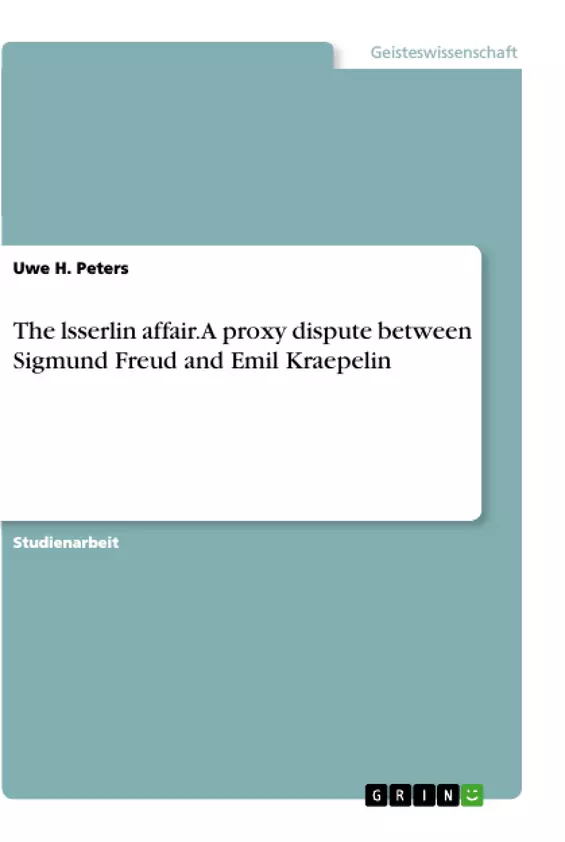This paper is about thr Isserlin affair.
Emil Kraepelin and Sigmund Freud have indirectly, via Max Isserlin and Carl Gustav Jung, disputed about their completely different blueprints of psychiatric or psychological disturbances. Mainly in the Max Isserlin-affaire the dispute reached personal and bitter forms. In this affair Bleuler sided with Kraepelin.
In the end of the dispute Bleuler just as Jung had separated from Freud, if in different ways and with different motivations. The discussion be- tween Kraepelin-Max Isserlin on the one side and Freud on the other faded away. The course of the dispute, which mainly the psychoanalytic literature alludes to frequently, is being delineated here for the first time.
Inhaltsverzeichnis
- Introduction
- Beginning of the dispute
- at the historic 37th hiking meeting of south-west German insane doctors (Irrenärzte) in Tübingen
- C. G. Jung's "Psychologie der Dementia praecox" (Psychology of dementia praecox) and the criti-cism of it on a scientific evening in Kraepelin's
- Max Isserlin's Critique of Freud
- There are also personal reasons for the dispute
- The conflict is widening the Isserlin affair takeshold
- Kraepelin visits Bleuler(1910 in Zurich)
- Bleuler separates from Freud, Jung also separates from Freud
- The aftermath of the Isserlin affair
- Conclusion
- Zusammenfassung
- Die Isserlin-Affäre
- References
- Max Isserlin's life and work
- Introduction
- Medical student and Kantian in Königsberg
- Max Isserlin's turn to psychiatry in 1903
- One year later,
- Postdoctoral lecture qualification 1910
- Interim between postdoctoral thesisand First World War
- Sickbay experiences during the First World War
- Heckscher and Max Isserlin
- Exkursion about Heckscher father and son
- August Heckscher
- Max Isserlin's Emigration and End
- Summary
- Zusammenfassung
- References
- The author
Zielsetzung und Themenschwerpunkte
Diese Arbeit befasst sich mit der „Isserlin-Affäre“, einem Streit zwischen C. G. Jung und Max Isserlin, in den auch Freud und Kraepelin verwickelt waren. Der Text verfolgt das Ziel, den Verlauf dieses Streits aufzuzeigen, der in der internationalen psychoanalytischen Literatur nur spärlich behandelt wird. Er beleuchtet die Hintergründe des Konflikts, die unterschiedlichen Positionen der Beteiligten sowie die Folgen für die Entwicklung der Psychoanalyse und der Psychiatrie.
- Der Streit zwischen C. G. Jung und Max Isserlin
- Die Einmischung von Freud und Kraepelin
- Die unterschiedlichen Positionen zur Psychoanalyse und Psychiatrie
- Die Auswirkungen des Streits auf die Entwicklung der Psychoanalyse
- Der Lebensweg und das Werk von Max Isserlin
Zusammenfassung der Kapitel
Die Arbeit beginnt mit der Darstellung des Konflikts, der auf dem 37. Wandertag der Südwestdeutschen Irrenärzte in Tübingen 1906 begann. Jung und Isserlin trafen dort aufeinander und gerieten in Streit über Jungs psychologische Interpretation der Dementia praecox. Dieser Streit entwickelte sich zu einem persönlichen Konflikt und eskalierte weiter, als sich Bleuler auf die Seite Kraepelins stellte und auch Jung sich von Freud trennte. Der Text beleuchtet den Verlauf des Streits und analysiert die persönlichen Gründe für die Eskalation des Konflikts.
Im zweiten Teil der Arbeit wird der Lebensweg und das Werk von Max Isserlin beleuchtet. Der Text schildert Isserlins Werdegang, seine wissenschaftliche Arbeit und die Ereignisse, die zu seiner Emigration führten.
Schlüsselwörter
Isserlin-Affäre, C. G. Jung, Max Isserlin, Sigmund Freud, Emil Kraepelin, Eugen Bleuler, Psychoanalyse, Psychiatrie, Dementia praecox, Südwestdeutscher Irrenärzte, Tübingen, Wandertag, Psychologie, Streit, Konflikt, Emigration.
- Quote paper
- Prof. Dr. med. Dr. h.c. Uwe H. Peters (Author), 2021, The lsserlin affair. A proxy dispute between Sigmund Freud and Emil Kraepelin, Munich, GRIN Verlag, https://www.grin.com/document/1038700



